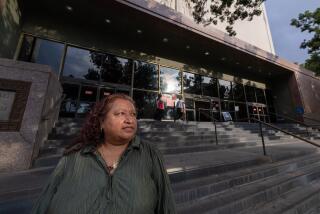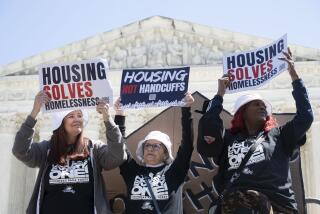Fight Boosts Cost of Homelessness : County Puts On Tenacious, Expensive Defense of Welfare Policy
Los Angeles County has paid a private law firm more than $360,000 in the last year, largely from funds earmarked for social services, to fight allegations that thousands of homeless people have been unfairly denied the $312-a-month benefits due them, county records show.
The bills submitted by the law firm, Parker, Millican, Clark, O’Hara & Samuelian, are expected to increase by several hundred thousand dollars by the end of the year as the lawyers prepare for a trial in December on one facet of the case.
It is an irony that irks lawyers for the Legal Aid Foundation of Los Angeles, the city attorney’s office as well as private attorneys who have donated their time over the last three years to press the complex class-action litigation.
“Their top lawyers get in an hour what a general relief person gets in a month,” said Julie P. Downey, an assistant city attorney involved in the case. “They’ve got to feel some kind of uneasiness about taking public dollars, especially with the reputation that lawyers have.”
Payment records for the last three months--an especially active period in the litigation--are not yet available, but the amounts are expected to be substantial. Billings for May alone were $129,000. Additional trials on other aspects of the case are expected to send the tab higher.
While the lawyers for the homeless find the legal fees particularly galling, the matter is only one of a number of issues that have emerged to make the litigation unusually contentious.
Time-Consuming Side Issue
Earlier this year, the lawsuit bogged down for several weeks after the county ordered researchers working for Legal Aid to leave the public waiting rooms of welfare offices or risk arrest. Legal Aid lawyers had to go to court to get an order allowing their researchers in the waiting rooms. Parker, Millican attorneys argued--unsuccessfully--that the researchers might confuse the welfare applicants.
Further, lawyers for the homeless claim that Parker, Millican is trying to wear them down by over-litigating, fighting “to the death” on even the most trivial matters. And, the lawyers contend, it would cost the county far less to settle the lawsuit and redesign its welfare application procedures than the county already has paid in legal fees.
“Settling would cost a trivial amount compared to what they’ve already paid” to the law firm, said Gary Blasi, an attorney for the Legal Aid Foundation. He estimated that it would cost the county $100,000 to overhaul its application system and begin paying benefits to those among the homeless who have been unable to navigate the welfare bureaucracy.
“Maybe the county has made a calculation that it’s cheaper to pay the lawyers,” Blasi said. “That’s the only bureaucratic justification I can think of for (paying) attorneys’ fees from welfare benefits.”
Parker, Millican lawyers vehemently deny that they are over-litigating the case. There is more than money at stake, they say--the county has denied all the allegations and wants to proceed to trial as a matter of principle. The lawyers say they are unaware which department is billed for their legal fees.
“We get a check from the County of Los Angeles and who knows where it came from,” said Karl Samuelian, a Republican fund-raiser who is the firm’s managing partner.
At issue in the litigation is whether the county is fulfilling its obligation under state law to provide aid to the indigent.
Lawyers for the homeless and the city of Los Angeles have made a broad-based attack on the county and its Department of Public Social Services, claiming that its welfare application procedure was intentionally designed to be so confusing that many among the poor and homeless simply cannot figure out how to apply.
Overwhelmed by Forms
The procedure, with its array of forms and questionnaires, is particularly baffling to the homeless mentally ill, who frequently wander into welfare offices and spend entire days standing in the wrong line, according to Blasi and others who have testified at depositions in the case. Disoriented and discouraged, many give up and return to the streets, Blasi said.
In 1986, when the first part of the lawsuit was filed, Superior Court Judge John L. Cole called the application process “a massive bureaucracy” and said some of the forms “appall me . . . I don’t understand some of the forms myself.” Cole ordered the county to come up with a procedure to help the mentally ill through the maze.
A year later, after a particularly harsh cold spell focused attention on the plight of the homeless, the city of Los Angeles sued the county in a broader attack on its handling of welfare programs.
By abdicating its responsibility to the poor, the lawsuit claimed, the county was passing the burden to the city. The county responded with a countersuit that accused the city of exacerbating the homeless problem by demolishing low-rent housing, especially in the Skid Row area.
Parker, Millican became involved in the case just more than a year ago after the county counsel’s office decided it was not equipped to handle the litigation. Since that time, the acrimony between the sides seems to have escalated.
“I spend at least half of my time on things about which there isn’t genuinely a dispute,” Blasi said. “The dynamic of the case has been that they fight everything tooth-and-nail up to the last minute, and then they collapse.”
Routine Request
In one incident last year, lawyers who donated their time to the city’s part of the case filed what they considered a routine request to submit a brief longer than the 15 pages permitted under local court rules.
Opposing lawyers almost never object, and judges rarely are hard-nosed about it, the lawyers said.
Yet Parker, Millican sent two lawyers to court for a special hearing to argue at some length against any breach of the 15-page limit. The judge overruled their protests.
“They made some pretty frivolous arguments,” said Alan D. Bersin, a lawyer from the firm of Munger, Tolles & Olson whose time has been donated to the case along with that of several others in the firm.
“What I find very strange is the apparent directive that’s been given to oppose on every ground,” he said.
In another incident, the lawyers say, Parker, Millican insisted on taking the deposition of a city official at a time when the official had other commitments.
“That typically is arranged amicably,” said Downey, of the city attorney’s office. Instead, Parker, Millican filed briefs on the matter and asked the judge to intervene, she said.
‘Like a Bunch of Kids’
“It’s a silly thing, and I don’t know how much they charged for it,” Downey said. “In the end, the court made us go out in the hall like a bunch of kids and work it out. It was wasteful in the extreme.”
Nowland C. Hong, the lead Parker, Millican attorney on the case, said the county has no choice but to defend itself vigorously against the allegations.
“There is undoubtedly a substantial cost involved in this litigation, but I think it certainly involves issues that are extremely important to the citizens of the country and the citizens of the county,” Hong said.
“I don’t think we have been either over-lawyering the case or been exceptionally tenacious. We have agreed to a lot of things.”
By filing its lawsuit, Hong said, the city cut off a cooperative effort that got under way in 1987 to find solutions to the homeless problem.
“My personal opinion is that a lawsuit is a very poor mechanism to be deciding public policy . . . questions of this nature,” Hong said.
The county estimates that there are between 35,000 and 50,000 homeless people on the county’s streets, as many as one-third of them severely and chronically mentally ill or developmentally disabled.
Little Change
As the litigation approaches its fourth year, lawyers for the homeless charge that little has improved. The county has largely ignored Judge Cole’s 1986 order to identify mentally ill applicants and offer them special help, they say. In fact, they claimed in a recent court filing, the process has become even more arduous and complex for the mentally ill than it was before.
One such person is Wesley Young, 28, who in April filed a declaration with the court describing his encounter with the welfare system.
“I kept having weird ideas pop into my head out of nowhere,” Young said. “I’d sleep along freeway entrances. . . . I even ate out of dumpsters.”
Sometimes, he said, he would awaken and have no idea where he was or how he got there.
Eventually, he found his way to the social services office in Rancho Park.
“After about an hour I figured out which window to start at; and I felt strong enough to go up to the window and begin,” he said. In the late afternoon, he was given a “bunch of papers to fill out.”
But by then it was closing time and “a guard came over to me and told me it was time to go . . . I went back to the beach that night.”
As the days grew colder, he said he decided to try another office and walked the distance of five miles. After an hour and a half in line, he was given another set of papers to fill out.
“I did the papers as best I could and got back in line,” he said. “But before I could get to the front of the line, the guards came in and said I had to go. I didn’t even fight it. I just went outside and cried.
“It took me probably three days to make it back to the beach. Living outside wasn’t as hard as all that.”
More to Read
Sign up for Essential California
The most important California stories and recommendations in your inbox every morning.
You may occasionally receive promotional content from the Los Angeles Times.






